You know me, I like to get my feet involved when I use my computer, which happens pretty much all day every day at this point. My cache of pedal inputs keeps growing like mushrooms in the darkness under my desk: every upper case letter in this post and dozens more have been capitalized with a shift pedal!
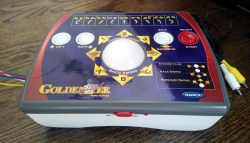 Naturally, I’ve thought about what it might be like to mouse with my toes. The more time I can spend with both hands on the keyboard, the better. I started sniffing around for foot-sized trackball candidates, thinking maybe I could just build one with regular mouse guts. Then I found a 15-year-old Golden Tee home edition console at a thrift store. It has a large ball and four buttons, so it seemed ripe for turning into a mouse as-is, or just stealing the ball to build my own. So far, that hasn’t happened, though I did solder a bunch of wires for testing out the controls.
Naturally, I’ve thought about what it might be like to mouse with my toes. The more time I can spend with both hands on the keyboard, the better. I started sniffing around for foot-sized trackball candidates, thinking maybe I could just build one with regular mouse guts. Then I found a 15-year-old Golden Tee home edition console at a thrift store. It has a large ball and four buttons, so it seemed ripe for turning into a mouse as-is, or just stealing the ball to build my own. So far, that hasn’t happened, though I did solder a bunch of wires for testing out the controls.
Then I found out about this almost-perfect, existing mouse that resembles a sunny-side-up egg. Its trackball is much bigger than the Golden Tee’s, maybe even twice as big. And more of the ball is exposed, so it’s way easier to roll than the one on the console, regardless of what appendage is used.
This is a BIGtrack mouse. You’re right, it looks like something Fisher Price would market to toddlers. But this is an assistive device for people of all ages. It has a 3″ trackball and buttons that are just over 1″ across. This friendly-faced egg mouse weighs just over a pound, most of which is in the trackball. I think it would survive just fine living on the floor underneath my foot — the shell is made of thick plastic and seems sturdy.
This mouse has a cool feature for people with low mobility who are unable to drag and drop the traditional way. They call it drag lock. If you hover the cursor over the item you want to move and double click the right mouse button, the drag lock is enabled. Drag it wherever you want, and click either of the buttons to let it go.
The electronic bay is crawling with BIGtrack mice both young and old, and after a few months of email alerts, I found one in my price range. They were originally made by Infogrip, which is the same company who made the BAT chording keyboard I roared about in the last installment of this column.
As we learned then, Infogrip has gone out of business, and their old stock is being sold by Boundless AT and possibly others. But unlike the BAT keyboard, AbleNet appears to be making new BIGtracks and selling them as BIGtrack 2 in several places, including the online version of the fruit phone store. AbleNet have improved this mouse a bit by using two different colors for the buttons, which makes them easily distinguishable. There’s also a wireless version that can use either a USB dongle or Bluetooth. It has a slider switch on the back if you want to keep the drag lock function on all the time.
The BIGtrack has one fatal flaw as far as I’m concerned — there’s no scroll wheel. Total deal-breaker for me as a mouse replacement. I’d have to add a clickable rotary encoder if I wanted to use this as my daily driver. Of course, while I’m at it, I might as well add two extra buttons to cover the copy/paste shortcuts I have come to depend on to help save my pinkies and ulnar nerves.
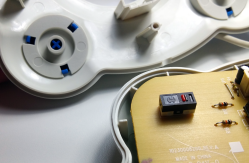
These Buttons Push My Buttons
Despite being loud, clicky, and blue, these buttons fall short of being satisfying. In fact, they take quite a bit of force to actuate. For buttons on an assistive device, these don’t seem friendly for people who lack fine motor skills or have low mobility. I think the fault lies with both the buttons and the switches.
The problem with the buttons is that they pretty much have to be pressed dead center if you want the click to register. Pressing along the edge works about half the time, and incidentally, it makes the spring sing a bit upon release, like a Model M keyboard.
But these are big buttons on a piece of assistive technology, so they should be easy to actuate. Shouldn’t you also expect to be able to press them anywhere from dead center to the edge and have them click and release without issue? I say yes.
Then there’s the matter of how long it takes to press the buttons. There is an absurdly long travel distance before the button even touches the switch actuator. Then when the stem finally reaches the switch, it’s hitting an actuator that measures 4 mm x 1 mm.

Bigger, Better Buttons
These button problems may be part of the reason that they came out with the “switch adapted” version, which is what I have. Both buttons are wired internally to 1/8″ phono jacks that allow you to plug in Buddy Buttons: specially-designed assistive tech buttons that are much larger and activate almost effortlessly.
That’s not breathless hyperbole — I have access to one, and they are designed quite well. Press it literally anywhere and it clicks, and the action is identical all over the thing. These buttons are ludicrously expensive, but could be easily emulated with a low-travel arcade switch wired to an 1/8″ plug and placed in a sturdy housing.
I’d love to see exactly what’s going on inside the Buddy Button, but I hesitate to take it apart because it’s not mine. I suspect that it is superior to the BIGtrack mouse buttons because of better distribution of force from the button to the switch.
Dissection
The BIGtrack, on the other hand, was easy to open — three screws in the circle of six were in plain sight, and the other three were hiding under adhesive rubber feet. Since this is the switch-adapted version, I also had to unscrew the nuts on the phono jacks to get the halves apart.
Inside, it’s a ball-mouse. A trio of rollers of middling quality connect to opto-interrupters, and a Cypress mouse chip does the rest. The plastic rollers are a bit of a disappointment, because plastic on plastic can only last so long, and a heavy track ball riding on them with the partial weight of a leg on top will not prolong the life any.
Still, I think this is a good assistive technology mouse because the trackball is so large. Hopefully, AbleNet has made the buttons more user-friendly in the newer versions. It’s unfortunate that these types of devices cost as much as they do, but at least the options are out there.


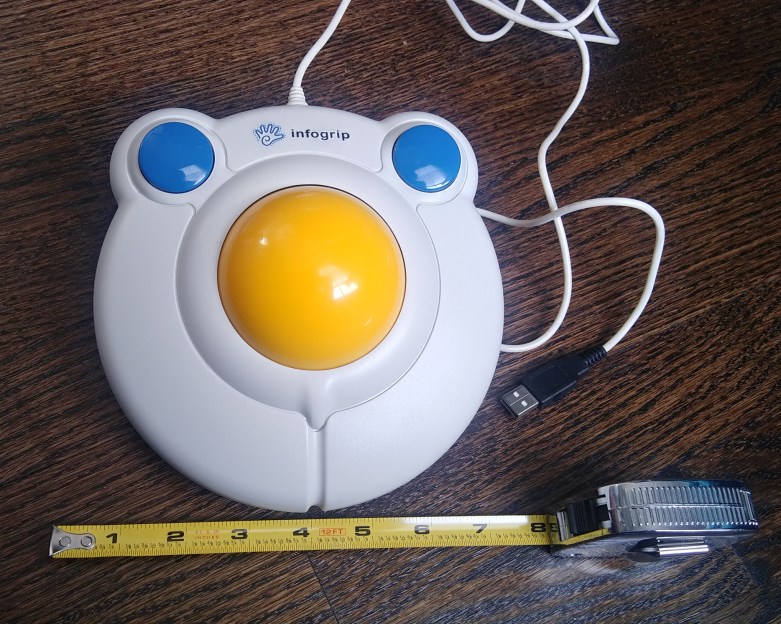

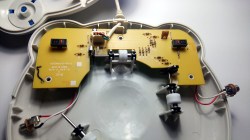
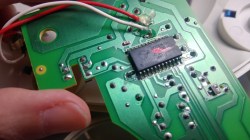














Are you familiar with QLF in Ham Radio parlance?
https://www.qsl.net/w5www/qcode.html
Does that mean something like “posting a link that doesn’t contain what you are referring to”?
Fortunately Google and a good guess brought up this:
https://acronyms.thefreedictionary.com/QLF
I have one of these somewhere! It’s a Crayola branded one and is old enough to require a serial port to use. I always found the movement unpleasant, like a ball mouse with perpetually dirty rollers…
Now I’m looking at a junk box optical mouse and I’m thinking that tiny circuit board could easily fit in the case!
That might well be because it is a ball mouse with dirty rollers.. I too have a some serial trackballs one of which is rather similar if not the same as the one above.. Not all created equally but if you clean the rollers off the one I have that looks like this is pretty smooth, take the rollers out and just have some delrin? skid points and an optical sensor you really could have one pretty neat mouse..
But being a trackball it will still get dirty – so unless your skid points can shed the dirt easily out of the case its still manual cleaning out – my favourite Kensington large trackball even at its dirtiest is pretty smooth but you really can tell when its just been cleaned out.. And the cheaper Logitech one really needs fanatical cleaning to feel nice to use..
A long long time ago (back in the late ’80s) I learned that the best mouse pad was a blank piece of paper, because it actually took the grime off of the ball, which kept the rollers clean. I don’t think that trick will help with a “foot ball” mouse unless you wear paper socks or something.
Remember the Atari trackball? It has a pool ball and 2 thick metal rods with heavy duty ball bearings for the roller.
Have you considered the kensington expert or slimline trackball for use with your foot? I just put mine on the floor, and using my left foot I was able to navigate with decent ease. Depending how dexterous your toes are you can even use the scroll wheel, or press a button with one foot and select text with the other foot. I just did this whole comment, including using a right click menu for spellcheck, mousing with my foot
Have you considered using a joystick ?
I recall once seeing something about an enormous home-built plywood joystick in a Commodore magazine that was controlled with the feet.
A giant optical mouse the size of an A4 sheet of paper might also be a good foot interface…
Did you know about the Microsoft Easyball? It’s a similar-looking big yellow trackball. But it’s old enough to have a serial (RS-232) interface, and it only has one button (I expect the mouse chip inside it has pins for more buttons).
Got one of those somewhere a really horrible to use but ‘indestructible’ trackball.. Can’t confirm if it has the buttons capacity though, as I’ve never looked at how it works.
Was the first mouse I ever used and has been in a box for quite some time now.. But it survived me, my sister and two of our cousins before it got dumped back on me still in perfect working order…
Re: the fatal flaw of no scroll wheel. Under the assumption that this thing would be operated with the feet, I am not sure about the feasibility of a scroll wheel. Sure, it’s a no-brainer when operated with fingers, but I do applaud your dexterity if you are able to perform similar scrolling action with your toes. I know I cannot do it.
Hmmm… maybe use something like a pair of throttle pedals for the scroll wheel. I’d love an excuse to install a Tilton pedal box under my desk! Or use an old fashioned sewing machine treadle to spin a giant scroll wheel, although this would also need a separate forward and reverse control.
the forward vs reverse is easy enough – put the pivot in the middle of the treadle (which at least some did as I’ve seen a few) and its simply a case of did you tilt back or forward to start
Consider making a touchpad out of a touchscreen digitizer?
Might not be the best option while wearing shoes, but if nothing else, it would be easier to keep clean.
Foot controls for doing LISP’s “(” and “)”.
For anyone looking to build this stuff from scratch. Suzo Happ is the company to find these large arcade trackballs, buttons, etc. Not affiliated in any way, just used them to fix some arcade consoles in the past.
For a scroll wheel, you might look at the Griffon Powermate. It’s a dial control, so it’d be horizontal instead of vertical like a normal mouse scroll wheel, but that might be easier to use with a toe than vertical anyway.
I’m not sure what OS you’re running, but the latest, but still old, drivers and software for Windows do work on Windows 10, and let you program it for different functions including a scroll wheel and do functions if you click it in.
Huh. They have a Bluetooth version now instead of just the old USB version I was talking about. I had thought they’d abandoned the product entirely, but I guess they brought it back at some point.
I’m impressed by anyone who can use their feet and hands and look at the screen at the same time like that. That’s a large number of movements, in different orientations that don’t match the screen, and the feet aren’t even in the peripheral vision! That would be way too many context switches for me.
I think I’d be more productive with one of those tiny 3 inch wireless keyboard mouse combos than this, but I know some people who could really make amazing use of it.